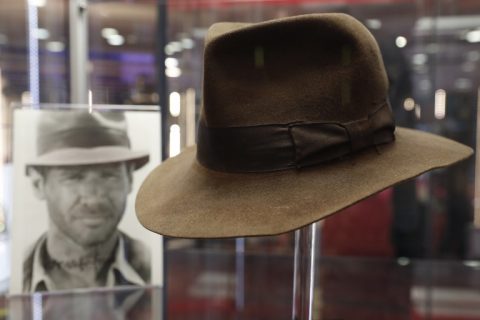By Emilie BICKERTON
PARIS (AFP) – Indiana Jones turned archaeology into a swashbuckling adventure of snake pits and lost treasures.

As 80-year-old Harrison Ford dons the beat-up fedora and ever-trusty whip for a fifth and final outing in “Indiana Jones and the Dial of Destiny”, premiering at the Cannes Film Festival on Thursday, here are six facts about one of the world’s best-loved movie heroes:
– Born in Hawaii –
Fittingly for the globetrotting Indy, whose escapades have taken him from the Himalayas to Shanghai nightclubs, the project was born in Hawaii.
It was there, lounging on a Maui beach in 1977, that George Lucas and Steven Spielberg mulled ideas to follow their respective hits, “Star Wars” and “Jaws”.
The beach brainstorms would make movie history.
Produced by Lucas and directed by Spielberg, 1981’s “Raiders of the Lost Ark” was a triumph at the box office and scooped four Oscars.
Two sequels — “Indiana Jones and the Temple of Doom” (1984) and “Indiana Jones and the Last Crusade” (1989) — built a legend that has inspired theme parks, video games and mountains of merchandise.
A fourth outing nearly two decades later, “Indiana Jones and the Kingdom of the Crystal Skull” brought the combined box office takings to nearly $2 billion.
– Dog’s name –
The inspiration behind the character came from both real and imaginary sources.
There was the archaeologist Hiram Bingham who discovered Machu Picchu, Tintin creator Herge, and Clint Eastwood’s Westerns.
As for the name, Lucas first chose Indiana Smith — changed to “Jones” by Spielberg — taking the first part from his Alaskan Malamute pet dog, already the inspiration for Chewbacca in “Star Wars”.
– Bond without the gadgets –
Although Spielberg dreamed of directing a James Bond film, Lucas insisted part of Indy’s appeal was that this hero would be a “Bond without the gadgets”.
There would be no explosive watches or Aston Martins with ejectable seats — Indy would triumph with ropes, knives and ingenuity.
He bore all the hallmarks of a classic Lucas-Spielberg character: a geeky hero with a comical, ironic side, whose affairs with women were more complicated than any Bond-style conquests.
– Spielberg’s comeback –
While the Indiana Jones project was brewing, Spielberg was on the back foot after his film, “1941”, flopped.
He was also gaining a reputation as a big-spending director who ran overtime and could be tyrannical on set, even leaving two days early from the filming of “Jaws”, fearing his team would try to drown him, such was his unpopularity.
Lucas’s project marked a career turning point for Spielberg — proving he could work fast, on time, in budget, and with big success.
– Ford not first choice –
Spielberg wanted Ford, but Lucas was reluctant to re-use his lead actor from “Star Wars”, from which he wanted a break.
Nick Nolte, Jeff Bridges and Bill Murray were considered before the spotlight settled on Tom Selleck, but the moustachioed charmer had already signed up for TV detective show “Magnum, PI”.
Later, thousands of actresses tried out for the role of Willie in the second film, including Sharon Stone, but it finally went to Kate Capshaw.
Capshaw did not go on to a glittering Hollywood career, but she did become Mrs Spielberg in 1991.
– Eye of the cobra –
Indy’s extreme fear of snakes, or ophidiophobia, has been a frequent plot point.
For the classic scene in which Indy falls into a pit full of the slithering reptiles, Spielberg did not hold back on the props: 6,500 live cobras, plus a few bits of watering hoses.








